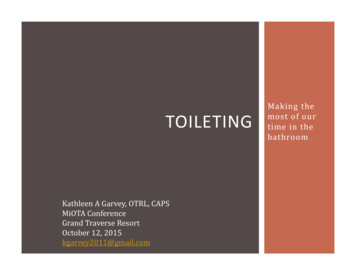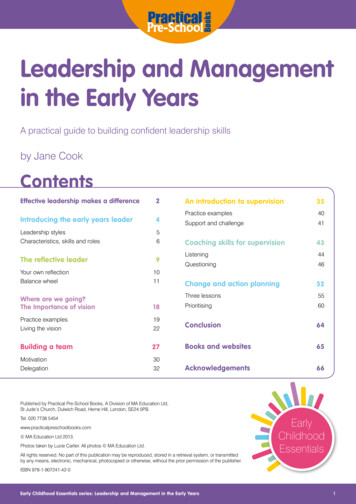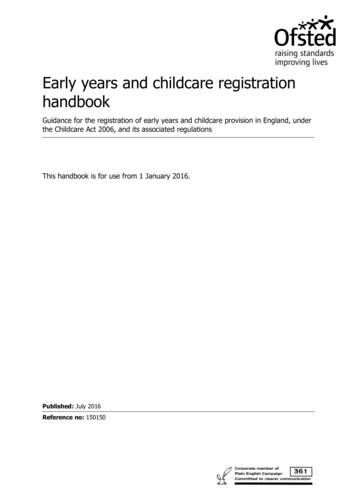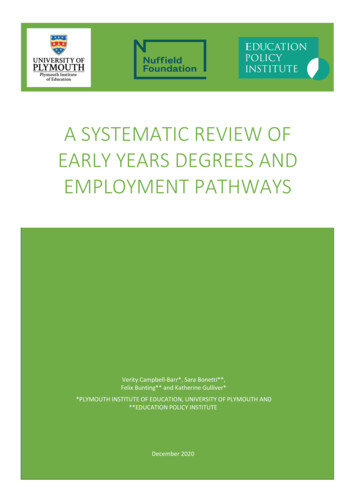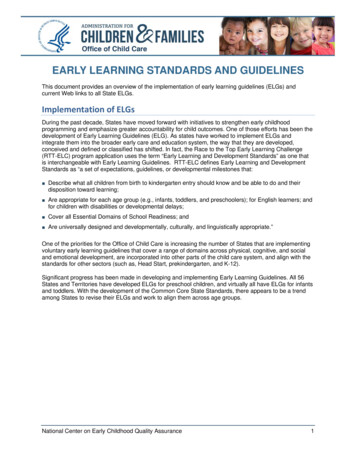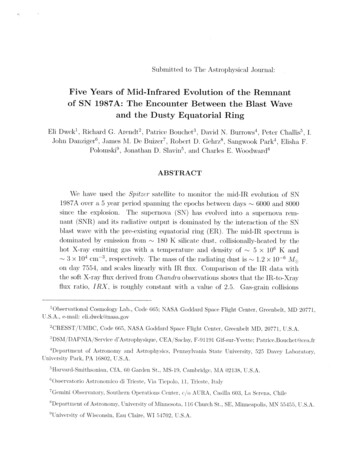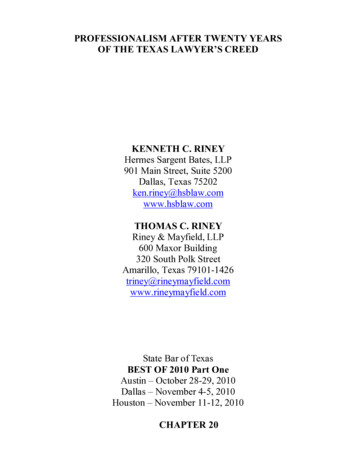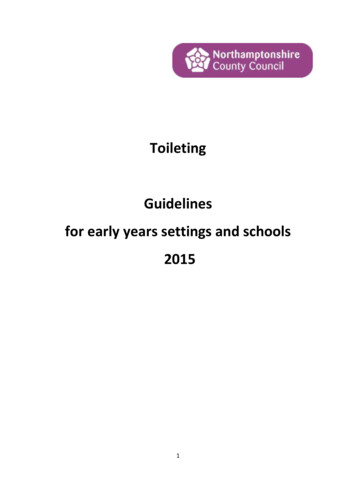
Transcription
ToiletingGuidelinesfor early years settings and schools20151
ContentsToileting Guidance . 3Intimate Care – All settings . 5Early Years Settings . 7Reception and key stage 1 & 2 changing policy . 9Key stage 3/4/5 Toileting and Changing Policy. 11Children and Young People with Autism Spectrum Disorders (ASD) . 13Risk assessment for medical gloves used in toileting procedures. 19Assessing the risks of facilities . 21Handwashing Technique . 23Resources . 24National Guidelines . 25Contacts list . 26Appendices:Appendix 1: Example Toileting plan for use in early years settings.Appendix 2: Antecedent Behaviour Consequence ChartAppendix 3: Social Story Using the toiletAppendix 4: Toilet flow chartAppendix 5: Toilet schedule.For further resources for toilet readiness and toilet training or students with Autism SpectrumDisorders please refer to contacts list.2
Toileting GuidanceAim of this guidanceThe aim of this guidance is to share best practice and statutory legislation with those adults in a widevariety of early year’s settings and schools who work with and have responsibility for children whoare in nappies, not yet toilet trained or who have additional developmental or medical needsaffecting toileting.It has been compiled by practitioners from Health, Social Care and Education agencies taking advicefrom Health and Safety colleagues and will need to be locally adapted to meet the individualcircumstances of the setting or school.While general principles apply it is expected that a toiletting plan for each child will be personalisedto meet their individual needs. Should queries arise about interpretation and application of thisguidance, you can seek clarification from the services listed under “Contacts”Our Ethos and PrinciplesToileting issues should not prevent any child from accessing education and should a child havetoileting needs it is the expectation that schools will address this as part of their holistic educationand development.Principles Early year’s settings and schools may find it useful / necessary to refer to various nationalstandards (legislation, codes of practice, generic guidance etc) and their own policies etc whereappropriate when developing a toileting policy.National Standards Keeping Children Safe in Education 2014Equalities ActSEN code of practiceOFSTED guidanceSupporting pupils at school with medical conditions 2014 (DfE)3
NICE guidelinesHealth and Safety legislationStatutory Framework for Early Years Foundation StageNorthamptonshire’s Special Educational Needs DescriptorsLocal policies and guidelines including: Safeguarding-including Child ProtectionEqualitiesAdmissionsInclusionSupporting pupils at school with medical conditionsIntimate careInfection controlHealth and safetyHazardous waste disposalPersonal protective equipment provisionManual handling arrangementsOff site activities including swimming poolsCode of ConductProfessional and best practiceInformation, instruction and trainingAdults assisting children and young people with their toileting needs should be provided withsufficient information, instruction and training to enable them to carry out their work safely andwithout significant risk to their health and that of others.4
Intimate Care – All settingsDefinitionIntimate care can be defined as any care which involves washing, touching or carrying out an agreedprocedure to intimate personal areas in order to care for another person. This may be due to theiryoung age, physical difficulties or special needs. Examples include continence and menstrualmanagement as well as washing, toileting or dressing.Intimate care tasks are associated with bodily functions, body products and personal hygiene thatdemands direct or indirect contact with, or exposure of the genitals.It also includes supervision of children and young people involved in intimate self-care.Best practice includes ensuring that: All intimate care is provided in a manner so as to maintain the child’s or young person’sdignity and confidence.The child or young person is cared for in a way that avoids distress, embarrassment or pain.Staff are regularly trained regarding child protection and health and safety, (which mayinclude manual handling), and are fully aware of infection control, including the need towear disposable aprons and gloves.A member of the trained staff (who is ideally familiar to the child/young person) will workalongside a new or more inexperienced colleague when they are introduced to a child andtheir toileting routines.Staff work in partnership with the child or young person’s parents or carers, to discuss theirneeds, routines or preferences.Individual Health Care plans are written and agreed with parents/carers and whereappropriate with the young person.All children and young people are supported to achieve the highest level of autonomy that ispossible, given their age and ability. Staff will always encourage the child or young person todo as much as possible for him/herself as possible.As an additional safeguard, staff involved in meeting intimate care needs will not usually beinvolved in the delivery of sex education to the same children, wherever possible.Where a child or young person’s care plan does not include ‘intimate care’, parents/carerswill be informed the same day if their child has needed help with meeting intimate careneeds. (e.g. if soiled or passed urine).Information regarding intimate care is treated as confidential and communicated in person,by telephone, or by sealed letter, not through the home/school diary, or by any othermethod which is not confidential.Every child’s right to privacy is respected.Careful consideration is given as to how many staff might need to be present when a child oryoung person needs help with intimate care.Adults who assist a child or young person one-to-one are employees of the school and haveDBS checks at the appropriate level.If two members of staff are present to assist with intimate care procedures that they do nottalk over the child or young person.5
Staff inform another colleague when they are going to assist a child with intimate care.Cameras and mobile phones are never taken into bathroom areas.Whenever possible, staff should care for a child of the same gender.This intimate care policy should be read in conjunction with the schools’ policies as below (orsimilarly named): safeguarding policy and child protection procedures (including whistleblowing)staff code of conduct and guidance on safer working practicehealth and safety policy and proceduresSpecial Educational Needs policyPlus Northamptonshire County Council moving and handling people – guidance notespolicy for the administration of medicines6
Early Years SettingsToilet Training in Early Years settings must be recognised as intimate care.Intimate care tasks are associated with bodily functions, body products and personal hygiene thatdemand direct or indirect contact with, or exposure of the genitals.Intimate care is defined as any care which involves washing, touching or carrying out an invasiveprocedure that most children and young people learn to carry out for themselves, but which someare unable to do because of their age, physical difficulties, special needs or ill health.All children must be supported and encouraged to achieve the highest level of autonomy that ispossible, given their age and ability.All Staff must be DBS checked and regularly trained regarding child protection and health and safety,(which may include manual handling), to ensure that they are fully aware of infection control,including the need to wear disposable aprons and gloves.Starting toilet training. This should be planned and agreed in co-operation with the parents/carers.There should be a written plan, including timing of toilet visits (eg, after snack and lunchtimes), and who will be responsible for this in the setting (named key person and anotheradult well known to the child). See sample toileting plans- Appendix 1There should be liaison with parents/carers to ensure continuity with routines at home(Does boy stand or sit? do you use a potty or insert seat? Does your child need help withtheir clothing?).If parents are using ‘pull ups’ there should be a consideration of individual needs discussionwith parents about the reasons for phasing out of these, without causing the childconfusion. Many children use pull ups in the same way as a nappy and they can prolongtoilet training as a child does not feel that they are wet. They also mean that any accidentsdo not have to be dealt with straight away, so a child can become confused, especially ifthey are swapping between pull ups at nursery and pants at home. For individual children,pull ups may still be agreed as the most appropriate option.When a child has a specific medical or developmental conditions which could impact ontoileting management, then advice from the Paediatrician should be sought either by theparent/carer or with permission, the designated adult e.g. teacher or SENCO. Childrenreceiving chemotherapy – it is advisable to contact the child’s Oncology Nurse for specificguidance. Contact details should be available from the parent/carer.To maintain the young person’s dignity, appropriate facilities should be available e.g. adultvisitors or disabled toilet, rather than pupil toilet. This should be clean, warm and safe andhave a lockable cupboard for equipment.Parents/carers should be reassured that if their child has an accident, it is not a problem andchildren will not be made to feel that it is an issue.7
Best Practice Every child’s right to privacy will be respected. Careful consideration will be given as to howmany staff might need to be present when a pupil needs help with intimate care.Cameras and mobile phones should never be taken into bathroom areas by staff or children.Hygiene management. See local Health and Safety PolicyAll staff should follow good hygiene practices, which should include:Disposable gloves should be worn. See risk assessment for medical gloves.Disposable plastic apron should be wornSystems should be in place to deal with spillages appropriately and safely.Spillages must be cleaned according to local policy. Hot water and soap OR antibacterialspray or wipes are appropriate.Soiled disposable nappy to be placed in plastic nappy bag and disposed of according to localarrangements. Reusable nappy to be placed in double plastic nappy bag and returned toparent.Soiled clothing to be placed in double plastic bags and returned to parent/carer wherefacilities for sluicing are not available.Correct hand washing techniques should be followed.a) For adults, use hot water and soap. Dry hands with disposable paper towels.Antibacterial gel can then also be used.b) For child, hand washing to be done by, or supervised by adult.SettingAdvance consideration should be given to arrangements for offsite activities.Every child’s right to privacy must be respected.To maintain the child’s dignity they should be changed only in a designated changing area.This area should be clean, warm and safe.Appropriate facilities must be available – such as changing mat, toilet seat or potty.Parents will be asked to provide all necessary consumables which could include: nappies, babywipes, nappy sacks, and plastic bags for soiled clothing.Changes of clothing should be made available by parents/carers.8
Reception and Key Stage 1 & 2 Changing PolicyToilet Training, and routine support with personal hygiene in Primary settings must be recognised asintimate care.Intimate care tasks are associated with bodily functions, body products and personal hygiene thatdemand direct or indirect contact with, or exposure of the genitals.Intimate care is defined as any care which involves washing, touching or carrying out an invasiveprocedure that most children and young people learn to carry out for themselves, but which someare unable to do because of their age, physical difficulties, special needs or ill health.All children must be supported and encouraged to achieve the highest level of autonomy that ispossible, given their age and ability.All Staff must be DBS checked and regularly trained regarding child protection and health and safety,(which may include manual handling), to ensure that they are fully aware of infection control,including the need to wear disposable aprons and gloves.Toileting and changing children This should be planned and agreed in co-operation with the parents/carers.There should be a written plan, including timing of toilet visits (eg, after snack, lunchtimesand the end of the school day. lunch times), and who will be responsible for this in thesetting (named key person and another adult well known to the child). Always consider thetype of support required relevant to the child’s level of indepen
Appendix 4: Toilet flow chart Appendix 5: Toilet schedule. For further resources for toilet readiness and toilet training or students with Autism Spectrum Disorders please refer to contacts list. 3 Toileting Guidance Aim of this guidance The aim of this guidance is to share best practice and statutory legislation with those adults in a wide variety of early years settings and schools who work .
